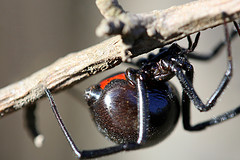 Nothing strikes fear in a person like a black widow spider sighting, in part, because its venom is reportedly 15 times that of a rattlesnake’s. Although most bite victims do not suffer serious damage (except that children, elderly, and physically infirm individuals are at greater risk for serious injury), a bite should not be ignored.
Nothing strikes fear in a person like a black widow spider sighting, in part, because its venom is reportedly 15 times that of a rattlesnake’s. Although most bite victims do not suffer serious damage (except that children, elderly, and physically infirm individuals are at greater risk for serious injury), a bite should not be ignored.
The female black widow spider is normally shiny black with a red hourglass marking on the underside of the abdomen. Late spring is mating season for black widow spiders. A female will produce approximately 200 eggs that hatch after about 30 days. It takes approximately 3 months for a black widow spider to reach adulthood. Keep an eye out for black widow spider nests in the early summer and more adult spiders in the early fall.
Black widow spiders are nocturnal and, thus, are active at night. However, be alert, they like outdoor areas (e.g., woodpiles, rubble piles, under rocks, hollow stumps, and rodent burrows, privies, sheds and garages) as well as some indoor areas (e.g., undisturbed, cluttered areas in basements and crawl spaces). Wear a long-sleeved shirt, hat, gloves, and boots when in areas prone to black widow spiders. Also inspect and shake out clothing and shoes before getting dressed, and consider using insect repellants on clothing and footwear.
Symptoms of a Black Widow Spider Bite
- The bite may be painful or not
- The bitten area may have one or two bite marks with local swelling
- Pain usually progresses from the bite site, and it may eventually progress to the abdomen and back
- Severe cramping or rigidity may occur in the abdominal muscles and, in some cases, it may mimic symptoms of appendicitis or gallbladder problems
- Symptoms may include nausea, vomiting, fainting, dizziness, chest pain, profuse perspiration, tremors, labored breathing, restlessness, increased blood pressure and fever
- Pain from the bite will usually persist for the first 8-12 hours
- Symptoms may continue for several days
Treatment of a Black Widow Spider Bite
- Clean the bite area with soap and water
- Apply ice to the bite area to slow absorption of the venom
- Elevate and immobilize the area bitten
- Capture the spider, if at all possible, so that the type of spider bite can be confirmed
- Seek medical attention immediately — The decision to seek emergency care should be made early and, if the person who was bitten by a black widow spider has more than minor pain or has whole-body symptoms, seek care at a hospital’s Emergency Department and, if symptoms are severe, call 911 for emergency medical transport so that evaluation and treatment can start en route to the hospital
- If you have a heart condition or other heart problem, you may need to be hospitalized
Be safe!
Additional Resources: OSHA Fact Sheet, Protect Yourself! Workers may be exposed to black widow spider; livescience, Black Widows: Facts & Information
Photo: peasap, Taken Jul. 22, 2007 – Creative Commons
 Gravel2Gavel Construction & Real Estate Law Blog
Gravel2Gavel Construction & Real Estate Law Blog


